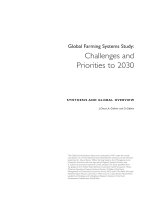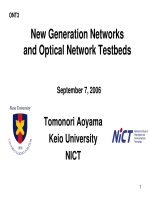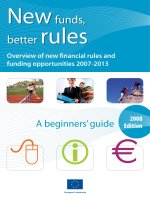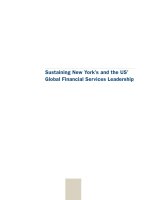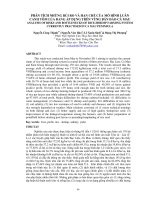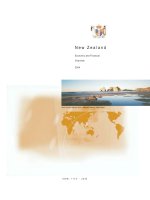New environmentally friendly and highly productive closed fish farming systems
Bạn đang xem bản rút gọn của tài liệu. Xem và tải ngay bản đầy đủ của tài liệu tại đây (11.04 MB, 100 trang )
A Guide to
Recirculation Aquaculture
An introduction to the new environmentally friendly and highly
productive closed fish farming systems
Key Features
Author: Jacob Bregnballe
• Assists farmers to convert to recirculation aquaculture
• Introduction to the technology and the methods of management
• Advise on good practise shifting to recirculation aquaculture
• Running a recirculation system, including education and training
• Case stories from different recirculation projects
The author, Jacob Bregnballe, from the AKVA group has worked all over the
world with recirculation aquaculture in research and practice for more than
30 years. He is one of the leading experts and has been involved in improving
recirculation systems for many species. He holds a master’s degree from
Copenhagen University and has been running his own fish farm for 25 years.
This guide is published by the Food and Agriculture Organization of the
United Nations (FAO) and Eurofish International Organisation.
Eurofish
H.C. Andersens Boulevard 44-46
DK-1553 Copenhagen V
Denmark
The FAO Sub-regional Office
for Central and Eastern Europe
Benczur utca 34
H-1068 Budapest, Hungary
Tel.: (+45) 333 777 55
Fax: (+45) 333 777 56
info@eurofish.dk
www.eurofish.dk
Tel.: (+36) 1 4612000
Fax: (+36) 1 3517029
www.fao.org/regional/seur
ISBN 978-92-5-108776-3
9
7 8 9 2 5 1
0 8 7 7 6 3
I4626E/1/05.15
2015
editio
n
Intro.indd 1
20/01/12 9:00 PM
A Guide to
Recirculation Aquaculture
An introduction to the new environmentally friendly and highly productive
closed fish farming systems
Author: Jacob Bregnballe
Published by
the Food and Agriculture Organization of the United Nations (FAO)
and
EUROFISH International Organisation
The designations employed and the presentation of material in this information
product do not imply the expression of any opinion whatsoever on the part of the
Food and Agriculture Organization of the United Nations (FAO), or of EUROFISH
International Organisation concerning the legal or development status of any
country, territory, city or area or of its authorities, or concerning the delimitation
of its frontiers or boundaries. The mention of specific companies or products of
manufacturers, whether or not these have been patented, does not imply that
these have been endorsed or recommended by FAO, or EUROFISH in preference
to others of a similar nature that are not mentioned. The views expressed in this
information product are those of the author(s) and do not necessarily reflect the
views or policies of FAO, or EUROFISH.
FAO and EUROFISH encourage the use, reproduction and dissemination of
material in this information product. Except where otherwise indicated,
material may be copied, downloaded and printed for private study, research and
teaching purposes, or for use in non-commercial products or services, provided
that appropriate acknowledgement of FAO and EUROFISH as the source and
copyright holder is given and that FAO’s and EUROFISH’s endorsement of users’
views, products or services is not implied in any way.
All requests for translation and adaptation rights, and for resale and other
commercial use rights should be made via www.fao.org/contact-us/licencerequest or addressed to
FAO information products are
(www.fao.org/publications)
and
available on the FAO
can
be
purchased
© FAO and EUROFISH, 2015
website
through
Preface
Stringent environmental restrictions to minimise pollution from hatcheries
and aquaculture plants in northern European countries have sparked the rapid
technological development of recirculation systems. However, recirculation also
secures a higher and more stable aquaculture production with less diseases
and better ways to control the hatchery parameters that influence growth.
This development is welcome and fully in line with the FAO Code of Conduct
for Responsible Fisheries. The present guideline on recirculation aquaculture
supplements the environmentally sustainable aquaculture work of the FAO
Subregional Office for Central and Eastern Europe.
The water recirculation technique also implies that hatcheries no longer
necessarily need to be placed in pristine areas near rivers. Now they can be built
almost anywhere with a much smaller source of clean germ-free water. It has
therefore been a pleasure for FAO to support the production of this guide which
we hope can inspire and help aquaculture farmers to adopt recirculation systems
in the future.
Thomas Moth-Poulsen
Senior Fisheries and Aquaculture Officer
FAO
-3-
A Guide to Recirculation Aquaculture
Already one of the world’s fastest growing agri-food sectors, aquaculture has
the potential for further growth in providing the world’s population with high
quality and healthy fish products. With global capture production of around
90 million tonnes, aquaculture production has maintained a constant annual
growth reaching a global production of about 70 million tonnes in 2013.
Increased focus on sustainability, consumer demands, food safety and cost
effectiveness in aquaculture production calls for the continuous development
of new production technologies. In general, aquaculture production affects
the environment, but state-of-the-art recirculation methods reduce this effect
considerably compared to traditional ways of farming fish. Recirculation systems
thereby offer two immediate advantages: cost effectiveness and reduced
environmental impact. This guide focuses on the techniques for the conversion
from traditional farming methods to recirculated aquaculture and advises the
farmer on the pitfalls to be avoided along the way.
The guide is based on the experience of one of the foremost experts in this area,
Jacob Bregnballe from the AKVA group. It is hoped that the guide will be a useful
tool for fish farmers who are considering converting to recirculation systems.
Aina Afanasjeva
Director
Eurofish
-4-
Preface
Introduction to the author Jacob Bregnballe and the AKVA group
Jacob Bregnballe from the AKVA group has been working with recirculation
aquaculture for more than 30 years. He has been running his own fish farm in
Denmark for 25 years, and has been involved in many technological innovations
for improving recirculation systems for a wide range of different aquaculture
species. He has also worked as an international aquaculture consultant, and holds
a master’s degree from Copenhagen University. Today he is the Business Director
of Land Based Aquaculture in AKVA group, the largest aquaculture technology
company in the world covering all aspects of aquaculture production both on
shore and at sea. The company has more than 30 years of experience in the
design and manufacture of steel cages, plastic cages, work boats, feed systems,
feed barges, sensor systems and fish farming software, and provides solutions
and support for any requirement in the field of recirculation aquaculture.
Jacob Bregnballe
AKVA group Denmark A/S
Roskildevej 342, Byg. 2
DK-2630 Taastrup, Copenhagen
Denmark
Tel.: (+45) 7551 3211
Mob.: (+45) 2068 0994
Fax: (+45) 7551 4211
www.akvagroup.com
-5-
Table of contents
Chapter 1: Introduction to recirculation aquaculture...........................................9
Chapter 2: The recirculation system step by step...............................................13
Chapter 3: Fish species in recirculation...............................................................35
Chapter 4: Project planning and implementation...............................................45
Chapter 5: Running a recirculation system.........................................................53
Chapter 6: Waste water treatment.....................................................................71
Chapter 7: Disease..............................................................................................79
Chapter 8: Case story examples..........................................................................85
References..........................................................................................................91
Appendix - Checklist when implementing a recirculation system......................93
-7-
Chapter 1: Introduction to recirculation aquaculture
Recirculation aquaculture is essentially a technology for farming fish or other
aquatic organisms by reusing the water in the production. The technology is
based on the use of mechanical and biological filters, and the method can in
principle be used for any species grown in aquaculture such as fish, shrimps,
clams, etc. Recirculation technology is however primarily used in fish farming,
and this guide is aimed at people working in this field of aquaculture.
Recirculation is growing rapidly in many areas of the fish farming sector, and
systems are deployed in production units that vary from huge plants generating
many tonnes of fish per year for consumption to small sophisticated systems
used for restocking or to save endangered species.
Recirculation can be carried out at different intensities depending on how much
water is recirculated or re-used. Some farms are super intensive farming systems
installed inside a closed insulated building using as little as 300 litres of new water,
and sometimes even less, per kilo of fish produced per year. Other systems are
traditional outdoor farms that have been rebuilt into recirculated systems using
around 3 m3 new water per kilo of fish produced per year. A traditional flowthrough system for trout will typically use around 30 m3 per kilo of fish produced
per year. As an example, on a fish farm producing 500 tonnes of fish per year,
the use of new water in the examples given will be 17 m3/hour(h), 171 m3/h and
1 712 m3/h respectively, which is a huge difference.
Figure 1.1 An indoor recirculation system.
-9-
A Guide to Recirculation Aquaculture
Another way of calculating the degree of recirculation is using the formula:
(Internal recirculation flow/(internal recirculation flow + new water intake)) x 100
The formula has been used in figure 1.2 for calculating the degree of recirculation
at different system intensities and also compared to other ways of measuring the
rate of recirculation.
Type of system Consumption
of new water
per kg fish
produced
per year
Consumption
of new water
per cubic
meter per
hour
Flow-through
30 m3
1 712 m3/h
1 028 %
0%
RAS low level
3m
3
171 m /h
103 %
95.9 %
RAS intensive
1m
3
57 m /h
34 %
98.6 %
3
3
Consumption Degree of
of new
recirculation
water per
at system
day of total vol. recycled
system water
one time
volume
per hour
RAS super
0.3 m
17 m /h
6%
99.6 %
intensive
Figure 1.2 Comparison of degree of recirculation at different intensities
compared also to other ways of measuring the rate of recirculation. The
calculations are based on a theoretical example of a 500 tonnes/year system
with a total water volume of 4 000 m3, where 3 000 m3 is fish tank volume.
3
3
Seen from an environmental point of view, the limited amount of water used in
recirculation is of course beneficial as water has become a limited resource in
many regions. Also, the limited use of water makes it much easier and cheaper to
remove the nutrients excreted from the fish as the volume of discharged water
is much lower than that discharged from a traditional fish farm. Recirculation
aquaculture can therefore be considered a most environmentally friendly way
of producing fish at a commercially viable level. The nutrients from the farmed
fish can be used as fertilizer on agricultural farming land or as a basis for biogas
production.
The term “zero-discharge” is sometimes used in connection to fish farming,
and although it is possible to avoid all discharge from the farm of all sludge and
water, the waste water treatment of the very last concentrations is most often a
- 10 -
Chapter 1: Introduction to recirculation aquaculture
Figure 1.3 An outdoor recirculation farm.
costly affair to clean off completely. Thus an application for discharging nutrients
and water should always be part of the planning permission application.
Most interesting though, is the fact that the limited use of water gives a huge
benefit to the production inside the fish farm. Traditional fish farming is totally
dependent on external conditions such as the water temperature of the river,
cleanliness of the water, oxygen levels, or weed and leaves drifting downstream
and blocking the inlet screens, etc. In a recirculated system these external
factors are eliminated either completely or partly, depending on the degree of
recirculation and the construction of the plant.
Recirculation enables the fish farmer to completely control all the parameters in
the production, and the skills of the farmer to operate the recirculation system
itself becomes just as important as his ability to take care of the fish.
Controlling parameters such as water temperature, oxygen levels, or daylight for
that matter, gives stable and optimal conditions for the fish, which again gives
less stress and better growth. These stable conditions result in a steady and
foreseeable growth pattern that enables the farmer to precisely predict when the
fish will have reached a certain stage or size. The major advantage of this feature
is that a precise production plan can be drawn up and that the exact time the
fish will be ready for sale can be predicted. This favours the overall management
of the farm and strengthens the ability to market the fish in a competitive way.
- 11 -
A Guide to Recirculation Aquaculture
Light
Temperature
Salinity
pH
Water Flow
Oxygen
Carbon
dioxide
Stocking
density
Feeding rate
Organic
material
Figure 1.4 Some of the parameters affecting the growth and well-being of a
fish.
There are many more advantages of using recirculation technology in fish
farming, and this guide will deal with these aspects in the following chapters.
However, one major aspect to be mentioned right away is that of diseases. The
impact of pathogens is lowered considerably in a recirculation system as invasive
diseases from the outside environment are minimised by the limited use of
water. Water for traditional fish farming is taken from a river, a lake or the sea,
which naturally increases the risk of dragging in diseases. Due to the limited use
of water in recirculation the water is mainly taken from a borehole, drainage
system or spring where the risk of diseases is minimal. In fact, many recirculation
systems do not have any problems with diseases whatsoever, and the use of
medicine is therefore reduced significantly for the benefit of the production and
the environment. To reach this level farming practice it is of course extremely
important that the fish farmer is very careful about the eggs or fry that he brings
on to his farm. Many diseases are carried into systems by taking in infested eggs
or fish for stocking. The best way to avoid diseases entering this way, is not to
bring in fish from outside, but only bring in eggs as these can be disinfected
completely from diseases.
Aquaculture requires knowledge, good husbandry, persistence and sometimes
nerves of steel. Shifting from traditional fish farming into recirculation does make
many things easier, however at the same time it requires new and greater skills.
To be successful in this quite advanced type of aquaculture calls for training and
education for which purpose this guide has been written.
- 12 -
Chapter 2: The recirculation system, step by step
In a recirculation system it is necessary to treat the water continuously to remove
the waste products excreted by the fish, and to add oxygen to keep the fish alive
and well. A recirculation system is in fact quite simple. From the outlet of the fish
tanks the water flows to a mechanical filter and further on to a biological filter
before it is aerated and stripped of carbon dioxide and returned to the fish tanks.
This is the basic principle of recirculation.
Several other facilities can be added, such as oxygenation with pure oxygen,
ultraviolet light or ozone disinfection, automatic pH regulation, heat exchanging,
denitrification, etc. depending on the exact requirements.
Fish tanks
Mechanical filter
Biofilter
Degasser
(Trickling filter)
UV disinfection
Oxygen enrichment
Figure 2.1 Principle drawing of a recirculation system. The basic water treatment
system consists of mechanical filtration, biological treatment and aeration/
stripping. Further installations, such as oxygen enrichment or UV disinfection,
can be added depending on the requirements.
Fish in a fish farm require feeding several times a day. The feed is eaten and
digested by the fish and is used in the fish metabolism supplying energy and
nourishment for growth and other physiological processes. Oxygen (O2) enters
through the gills, and is needed to produce energy and to break down protein,
whereby carbon dioxide (CO2) and ammonia (NH3) are produced as waste
products. Undigested feed is excreted into the water as faeces, termed suspended
- 13 -
A Guide to Recirculation Aquaculture
Figure 2.2 Eating feed and using oxygen results in fish growth and excretion of
waste products, such as carbon dioxide, ammonia and faeces.
solids (SS) and organic matter. Carbon dioxide and ammonia are excreted from
the gills into the water. Thus fish consume oxygen and feed, and as a result the
water in the system is polluted with faeces, carbon dioxide and ammonia.
Only dry feed can be recommended for use in a recirculation system. The use
of trash fish in any form must be avoided as it will pollute the system heavily
and infection with diseases is very likely. The use of dry feed is safe and also has
the advantage of being designed to meet the exact biological needs of the fish.
Dry feed is delivered in different pellet sizes suitable for any fish stage, and the
ingredients in dry fish feed can be combined to develop special feeds for fry,
brood stock, grow-out, etc.
In a recirculation system, a high utilization rate of the feed is beneficial as this
will minimise the amount of excretion products thus lowering the impact on the
water treatment system. In a professionally managed system, all the feed added
will be eaten keeping the amount of uneaten feed to a minimum. The feed
conversion rate (FCR), describing how many kilos of feed you use for every kilo
of fish you produce, is improved, and the farmer gets a higher production yield
and a lower impact on the filter system. Uneaten feed is a waste of money and
results in an unnecessary load on the filter system. It should be noted that feeds
especially suitable for use in recirculation systems are available. The composition
of such feeds aims at maximising the uptake of protein in the fish thus minimising
the excretion of ammonia into the water.
- 14 -
Chapter 2: The recirculation system, step by step
Pellet size
Fish size, gram
Protein
Fat
3 mm
40 – 125
43%
27 %
4.5 mm
100 – 500
42 %
28 %
6.5 mm
400 – 1200
41 %
29 %
3.0 mm
4.5 mm
6.5 mm
Fishmeal
22
21
20
Fish oil
9
10
10
Rape seed oil
15
15
16
Haemoglobin
meal
11
11
11
Peas
5
5
5
Soya
10
11
11
Wheat
12
11
11
Wheat gluten
5
5
5
Other protein
concentrates
10
10
10
Vitamins,
minerals, etc.
1
1
1
Composition, %
Figure 2.3 Ingredients and content of a trout feed suitable for use in a recirculation
system. Source: BioMar.
- 15 -
A Guide to Recirculation Aquaculture
Components in a recirculation system
Fish tanks
Tank
properties
Circular
tank
D-ended
raceway
Raceway
type
Self-cleaning effect
5
4
3
Low residence time
of particles
5
4
3
Oxygen control and
regulation
5
5
4
Space
utilization
2
4
5
Figure 2.4 Different tank designs give different properties and advantages. Rating
1-5, where 5 is the best.
The environment in the fish rearing tank must meet the needs of the fish, both
in respect of water quality and tank design. Choosing the right tank design, such
as size and shape, water depth, self-cleaning ability, etc. can have a considerable
impact on the performance of the species reared.
If the fish is bottom dwelling, the need for tank surface area is most important,
and the depth of water and the speed of the water current can be lowered
(turbot, sole or other flatfish), whereas pelagic living species such as salmonids
will benefit from larger water volumes and show improved performance at
higher speeds of water.
In a circular tank, or in a square tank with cut corners, the water moves in a
circular pattern making the whole water column of the tank move around the
centre. The organic particles have a relatively short residence time of a few
minutes, depending on tank size, due to this hydraulic pattern that gives a selfcleaning effect. A vertical inlet with horizontal adjustment is an efficient way of
controlling the current in such tanks.
In a raceway the hydraulics have no positive effect on the removal of the
particles. On the other hand, if a fish tank is stocked efficiently with fish, the
self-cleaning effect of the tank design will depend more on the fish activity than
- 16 -
Chapter 2: The recirculation system, step by step
Figure 2.5 An example of octagonal tank design in a recirculation system saving
space yet achieving the good hydraulic effects of the circular tank. Source: AKVA
group.
on the tank design. The inclination of the tank bottom has little or no influence
on the self-cleaning effect, but it will make complete draining easier when the
tank is emptied.
Circular tanks take up more space compared to raceways, which adds to the
cost of constructing a building. By cutting off the corners of a square tank an
octagonal tank design appears, which will give better space utilization than
circular tanks, and at the same time the positive hydraulic effects of the circular
tank are achieved (see figure 2.5). It is important to note that construction of
large tanks will always favour the circular tank as this is the strongest design and
the cheapest way of making a tank.
A hybrid tank type between the circular tank and the raceway called a “D-ended
raceway” also combines the self-cleaning effect of the circular tank with the
efficient space utilization of the raceway. However, in practice this type of tank
is seldom used, presumably because the installation of the tank requires extra
work and new routines in management.
Sufficient oxygen levels for fish welfare are important in fish farming and are
usually kept high by increasing the oxygen level in the inlet water to the tank.
- 17 -
A Guide to Recirculation Aquaculture
Figure 2.6 Circular tank, D-ended raceway, and raceway type.
Direct injection of pure oxygen in the tank by the use of diffusers can also be
used, but the efficiency is lower and more costly.
Control and regulation of oxygen levels in circular tanks or similar is relatively
easy because the water column is constantly mixed making the oxygen content
almost the same anywhere in the tank. This means that it is quite easy to keep
the desired oxygen level in the tank. An oxygen probe placed near the tank outlet
will give a good indication of the oxygen available. The time it takes for the probe
to register the effect of oxygen being added to a circular tank will be relatively
short. The probe must not be placed close to where pure oxygen is injected or
where oxygen rich water is fed.
In a raceway, however, the oxygen content will always be higher at the inlet
and lower at the outlet, which also gives a different environment depending
on where each fish is swimming. The oxygen probe for measuring the oxygen
content of the water should always be placed in the area with the lowest oxygen
content, which is near the outlet. This downstream oxygen gradient will make
the regulation of oxygen more difficult as the time lag from adjusting the oxygen
up or down at the inlet to the time this is measured at the outlet can be up to
an hour. This situation may cause the oxygen to go up and down all the time
instead of fluctuating around the selected level. Installation of modern oxygen
control systems using algorithms and time constants will however prevent these
unwanted fluctuations.
Tank outlets must be constructed for optimal removal of waste particles, and
fitted with screens with suitable mesh sizes. Also, it must be easy to collect dead
fish during the daily work routines.
- 18 -
Chapter 2: The recirculation system, step by step
Tanks are often fitted with sensors for water level, oxygen content and
temperature for having complete control of the farm. It should also be considered
to install diffusers for supplying oxygen directly into each tank in case of an
emergency situation.
Figure 2.7 Drumfilter. Source: CM Aqua.
Mechanical filtration
Mechanical filtration of the outlet water from the fish tanks has proven to be
the only practical solution for removal of the organic waste products. Today
almost all recirculated fish farms filter the outlet water from the tanks in a so
called microscreen fitted with a filter cloth of typically 40 to 100 microns. The
drumfilter is by far the most commonly used type of microscreen, and the design
ensures the gentle removal of particles.
Function of the drumfilter:
1. Water to be filtered enters the drum.
2. The water is filtered through the drum’s filter elements. The difference in
water level inside/outside the drum is the driving force for the filtration.
3. Solids are trapped on the filter elements and lifted to the backwash area by
the rotation of the drum.
4. Water from rinse nozzles is sprayed from the outside of the filter elements.
The rejected organic material is washed out of the filter elements into the
sludge tray.
- 19 -
A Guide to Recirculation Aquaculture
5. The sludge flows together with water by gravity out of the filter escaping the
fish farm for external waste water treatment (see chapter 6).
Microscreen filtration has the following advantages:
• Reduction of the organic load of the biofilter.
• Making the water clearer as organic particles are removed from the water.
• Improving conditions for nitrification as the biofilter does not clog.
• Stabilising effect on the biofiltration processes.
Biological treatment
Not all the organic matter is removed in the mechanical filter, the finest particles
will pass through together with dissolved compounds such as phosphate and
nitrogen. Phosphate is an inert substance, with no toxic effect, but nitrogen in
the form of free ammonia (NH3) is toxic, and needs to be transformed in the
biofilter to harmless nitrate. The breakdown of organic matter and ammonia is a
biological process carried out by bacteria in the biofilter. Heterotrophic bacteria
oxidise the organic matter by consuming oxygen and producing carbon dioxide,
ammonia and sludge. Nitrifying bacteria convert ammonia into nitrite and finally
to nitrate.
The efficiency of biofiltration depends primarily on:
• The water temperature in the system.
• The pH level in the system.
To reach an acceptable nitrification rate, water temperatures should be kept
within 10 to 35 °C (optimum around 30 °C) and pH levels between 7 and 8.
The water temperature will most often depend on the species reared, and is
as such not adjusted to reach the most optimal nitrification rate, but to give
optimal levels for fish growth. Regulation of pH in relation to biofilter efficiency
is however important as lower pH level reduces the efficiency of the biofilter. The
pH should therefore be kept above 7 in order to reach a high rate of bacterial
nitrifying. On the other hand, increasing pH will result in an increasing amount
of free ammonia (NH3), which will enhance the toxic effect. The aim is therefore
to find the balance between these two opposite aims of adjusting the pH. A
recommended adjustment point is between pH 7.0 and pH 7.5.
Two major factors affect the pH in the water recirculation system:
• The production of CO2 from the fish and from the biological activity of the
biofilter.
- 20 -
Chapter 2: The recirculation system, step by step
• The acid produced from the nitrification process.
Result of nitrification:
NH4 (ammonium) + 1.5 O2 → NO2 (nitrite) + H2O + 2H+ + 2e
NO2 (nitrite) + 0.5 O2 → NO3 (nitrate) + e
______________________________________
NH4 + 2 O2
↔ NO3 + H2O + 2H+
1
CO2 is removed by aeration of the water, whereby degassing takes place. This
process can be accomplished in several ways as described later in this chapter.
The nitrifying process produces acid (H+) and the pH level falls. In order to stabilize
the pH, a base must be added. For this purpose lime or sodium hydroxide (NaOH)
or another base needs to be added to the water.
0
90
10
80
20
70
30
60
40
50
50
40
60
30
70
20
80
10
90
0
5
6
7
8
9
10
11
12
+
100
NH4, (%)
NH3 , (%)
Fish excretes a mixture of ammonia and ammonium (Total Ammonia Nitrate (TAN)
= ammonium (NH4+) + ammonia (NH3)) where ammonia constitutes the main
part of the excretion. The amount of ammonia in the water depends however on
100
pH
Figure 2.8 The equilibrium between ammonia (NH3) and ammonium (NH4+) at
20 °C. The toxic ammonia is absent at pH below 7, but rises fast as pH is increased.
- 21 -
A Guide to Recirculation Aquaculture
the pH level as can be seen in figure 2.8, which shows the equilibrium between
ammonia (NH3) and ammonium (NH4+).
80
TAN-N [mg/L]
70
60
50
40
30
20
10
0
6
6.5
7
7.5
8
pH
Figure 2.9 The relation between measured pH and the amount of TAN available
for breakdown in the biofilter, based upon a toxic ammonia concentration of 0.02
mg/L.
In general, ammonia is toxic to fish at levels above 0.02 mg/L. Figure 2.9 shows
the maximum concentration of TAN to be allowed at different pH levels if a level
below 0.02 mg/L of ammonia is to be ensured. The lower pH levels minimises
the risk of exceeding this toxic ammonia limit of 0.02 mg/L, but the fish farmer
is recommended to reach a level of minimum pH 7 in order to reach a higher
biofilter efficiency as explained earlier. Unfortunately, the total concentration of
TAN to be allowed is thereby significantly reduced as can be seen in figure 2.9.
Thus there are two opposite working vectors of the pH that the fish farmer has
to take into consideration when tuning his biofilter.
Nitrite (NO2-) is formed at the intermediate step in the nitrification process, and is
toxic to fish at levels above 2.0 mg/L. If fish in a recirculation system are gasping
for air, although the oxygen concentration is fine, a high nitrite concentration
may be the cause. At high concentrations, nitrite is transported over the gills into
the fish blood, where it obstructs the oxygen uptake. By adding salt to the water,
reaching as little as 0.3 ‰, the uptake of nitrite is inhibited.
Nitrate (NO3-) is the end-product of the nitrification process, and although it
is considered harmless, high levels (above 100 mg/L) seem to have a negative
impact on growth and feed conversion. If the exchange of new water in the
- 22 -
Chapter 2: The recirculation system, step by step
system is kept very low, nitrate will accumulate, and unacceptable levels will be
reached. One way to avoid the accumulation is to increase the exchange of new
water, whereby the high concentration is diluted to a lower and trouble-free
level.
On the other hand, the whole idea of recirculation is saving water, and in some
instances water saving is a major goal. Under such circumstances, nitrate
concentrations can be reduced by de-nitrification. Under normal conditions, a
water consumption of more than 300 litres per kg feed used is sufficient to dilute
the nitrate concentration. Using less water than 300 litres per kg feed makes the
use of denitrification worth considering.
The most predominant denitrifying bacteria is called Pseudomonas. This is an
anaerobic (no oxygen) process reducing nitrate to atmospheric nitrogen. In fact,
this process removes nitrogen from the water into the atmosphere, whereby
the load of nitrogen into the surrounding environment is reduced. The process
requires an organic source (carbon), for example wood alcohol (methanol) that
can be added to a denitrification chamber. In practical terms 2.5 kg of methanol
is needed for each kg nitrate (NO3-N) denitrified.
Most often the denitrification chamber is fitted with biofilter media designed
with a residence time of 2-4 hours. The flow must be controlled to keep outlet
oxygen concentration at app. 1 mg/L. If oxygen is completely depleted extensive
production of hydrogen sulphide (H2S) will take place, which is extremely toxic
to fish and also bad smelling (rotten egg). Resulting production of sludge is quite
high, and the unit has to be back-washed, typically once a week.
Figure 2.10 Moving bed media on left and fixed bed media on right.
- 23 -

